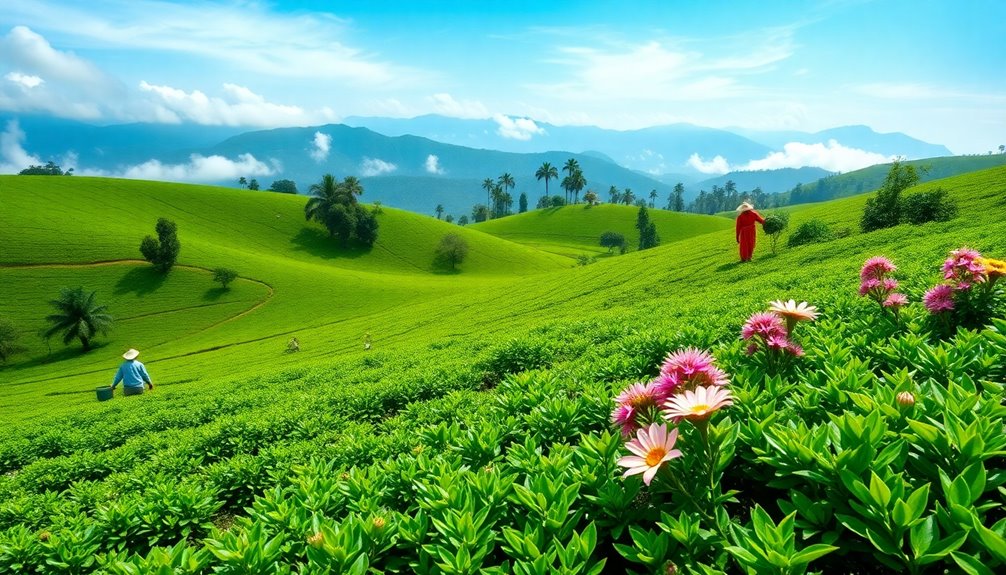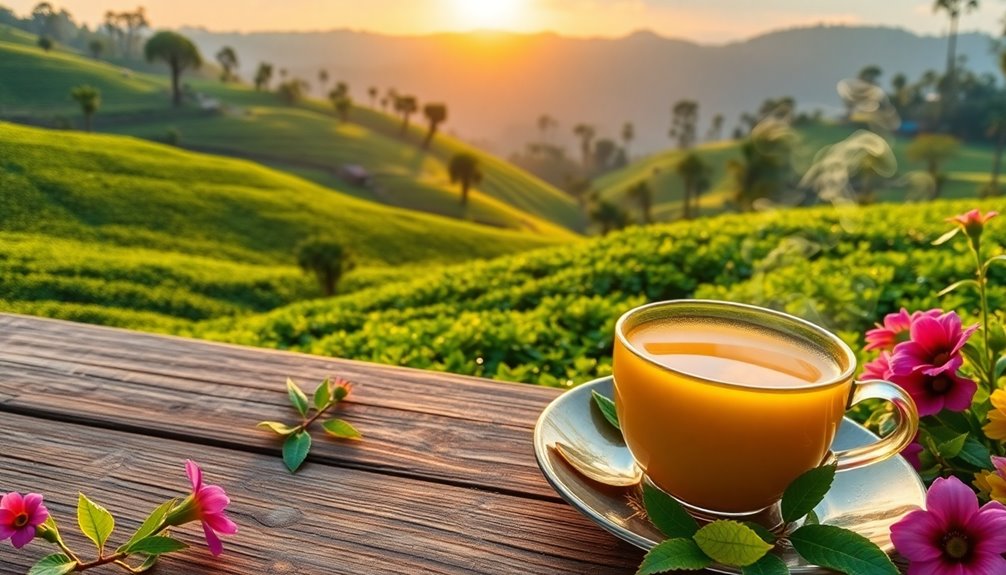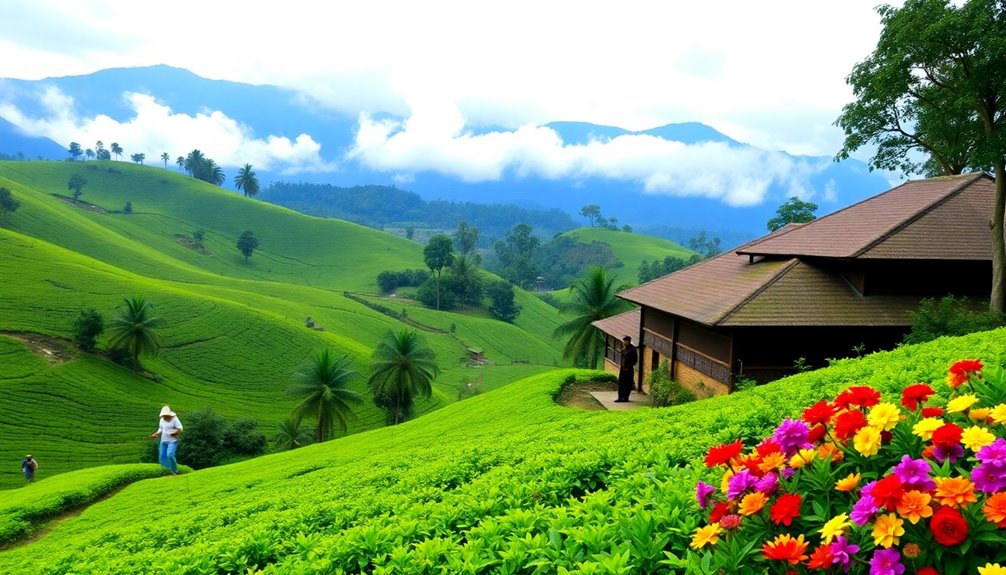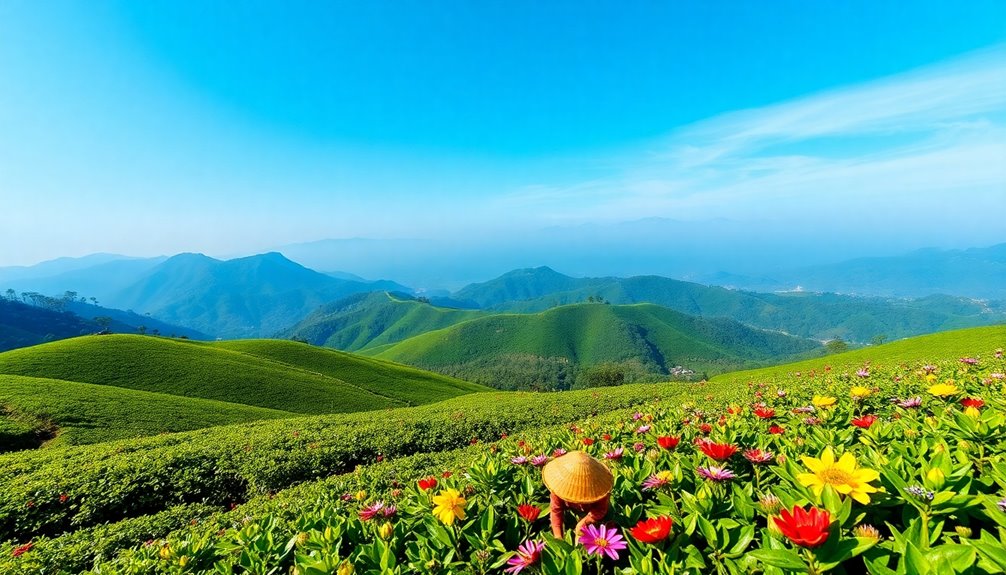Sri Lanka became a tea powerhouse because of its rich history and perfect growing conditions! Here's how:
- History: Tea was brought to the island in 1824 after coffee crops failed.
- Quality: High-altitude plantations produce some of the best flavors.
- Varieties: You can find delightful types like Nuwara Eliya and Dimbula.
- Reputation: Ceylon tea is loved worldwide for its unique taste and health benefits.
Thanks to hardworking farmers and their dedication, Sri Lanka became the largest tea exporter! Discover more exciting details about this journey and what's next for Ceylon tea!
Key Takeaways
- Tea was introduced to Sri Lanka in 1824, replacing coffee after a rust disease devastated coffee crops.
- James Taylor established the first commercial tea plantation in 1867, setting the foundation for the industry.
- The Colombo Tea Auction, established in 1883, became a crucial hub for global tea distribution and trade.
- Sri Lanka became the world's largest tea exporter in 1965, with production exceeding 200,000 metric tons annually.
- High-altitude plantations and diverse tea varieties contributed to Sri Lanka's reputation for quality Ceylon tea, enhancing its global appeal.
Introduction

Sri Lanka's transformation into a tea powerhouse showcases the resilience and adaptability of its agricultural practices. You might be surprised to learn that this beautiful island, once known as Ceylon, began its tea journey in 1824 when British planters introduced tea plants. This change came after a coffee rust disease affected coffee crops in the 1870s.
James Taylor is a key figure in this story. He established the first commercial tea plantation at Loolecondera in 1867, which marked the official start of the Ceylon tea industry. By 1883, the Colombo Auction held its first public tea auction, growing into the world's oldest and largest tea auction center.
Sri Lanka became the world's largest tea exporter for the first time in 1965, with tea production surpassing 200,000 metric tons in the 1960s.
Today, Sri Lanka ranks as the fourth largest tea producer globally, contributing 19% of the world's tea supply. The tea industry generates over US $1 billion in annual revenue from tea exports.
Isn't it exciting to discover how Sri Lanka became a beloved destination for tea lovers everywhere?
Ceylon Tea's Global Reputation
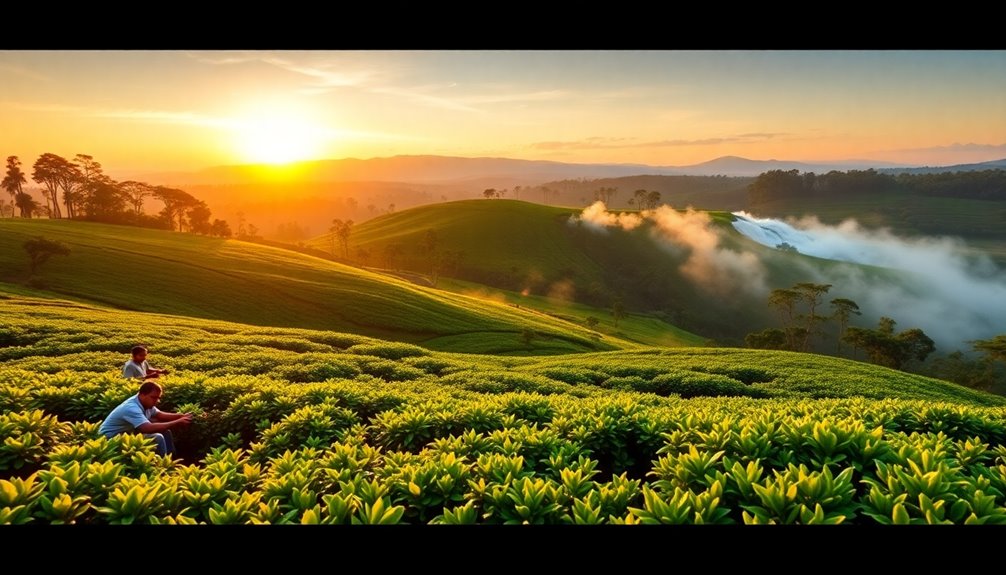
With its distinct aromas and flavor profiles, Ceylon tea has carved out a prestigious place in the hearts of tea lovers around the world.
Originating from Sri Lanka, this tea is famous for its quality, setting it apart from other teas like those from China and India.
Here are some exciting facts about Ceylon tea's global reputation:
- Largest Tea Exporter: By 2013, Sri Lanka became the largest tea exporter, fulfilling 19% of the global demand for tea!
- Colombo Tea Auction: The Colombo Tea Auction, the oldest and largest tea auction center in the world, distributes Ceylon tea globally.
- Economic Impact: In 2013, Ceylon tea production soared to over 340,000 metric tons, generating more than US $1.5 billion in revenue!
- Supportive Organizations: The Ceylon Tea Propaganda Board, established in 1932, and the Tea Research Institute, founded in 1925, have worked hard to promote Ceylon tea.
Additionally, the health benefits of Ceylon tea's antioxidants make it a favored choice among health-conscious consumers.
Thanks to these efforts, Ceylon tea holds a special place in your cup, making tea time even more delightful!
Enjoy the unique aromas and flavors that bring joy to families everywhere.
Ceylon's Diverse Tea Varieties

Ceylon's tea landscape is a treasure trove of diverse varieties, each reflecting the unique characteristics of its growing region. When you explore Ceylon tea, you'll discover a world of unique flavor profiles that will delight your senses.
- Nuwara Eliya: Known for its flowery aroma, this tea offers brisk caramel notes, perfect for those special moments.
- Dimbula: This region produces the famous Kirkoswold Silver Needles, a delicate white tea crafted from young buds, leaving a sweet honey finish.
- Kandy: Renowned for its robust flavors, Kandy tea has a rich history and a taste that warms the heart.
- Orange Pekoes: From the Lumbini Estate near Galle, these teas boast a bold coppery liquor, making every sip a treat.
If you're looking for something special, try the SFTGFOP-1 grade tea from the New Vithanakande estate. It's celebrated for its honey-like richness!
Each cup of Ceylon tea tells a story, inviting you to experience the charm of its diverse tea varieties. So, gather your family, brew a pot, and enjoy the wonderful flavors together!
Tea Plantations at High Altitudes

High-altitude tea plantations in Sri Lanka offer a unique experience for tea lovers, showcasing the remarkable flavors that cooler temperatures and misty conditions create. In regions like Nuwara Eliya and Dimbula, tea plants thrive above 1,200 meters, where the climate brings out unique floral aromas and brisk tastes that make these teas extraordinary.
Here's what makes high-altitude tea plantations so special:
- Cooler Temperatures: These cooler conditions slow the growth of tea plants, which leads to more concentrated flavors.
- Concentrated Flavors: The slower growth results in a distinct quality that you can taste in every sip.
- Signature Characteristics: High-altitude teas contribute to about 30% of all Ceylon tea produced in Sri Lanka, adding to the richness of the country's offerings.
Nuwara Eliya, often called "the champagne of teas," produces some of the finest quality teas you'll ever encounter. The blend of misty mornings and cool nights gives these teas their delightful taste, making them a favorite among tea enthusiasts.
Labor Disputes in Plantations

Labor disputes in Sri Lanka's tea plantations have a long and complex history, marked by the struggle for better wages and working conditions. Since the 1940s, estate workers, many of whom are Tamil workers from India, banded together to form trade unions. They sought fair treatment, demanding higher wages and improved working conditions.
- The Plantation Workers' Union, established in the 1930s, played a crucial role in advocating for workers' rights.
- These efforts intensified during the 1971-1972 nationalization of tea estates, which aimed to enhance workers' rights and manage estates better.
- However, government actions, like the introduction of export duties on tea in 1951, led to unrest. Workers protested for fair compensation and better treatment.
Despite these challenges, the determination of estate workers has shaped the tea industry. Their fight for equality and justice continues to inspire others.
As you enjoy a cup of Ceylon tea, remember the rich history behind it, where every sip reflects the hard work and resilience of those who've stood up for their rights. It's not just tea; it's a story of hope and perseverance!
Practical Applications

The history of labor disputes in Sri Lanka's tea plantations lays a foundation for understanding the practical applications of this vibrant industry today. Sri Lanka nationalized the tea industry, leading to remarkable growth. The first public Colombo Auction in 1883 created a bustling market for tea, turning the city into the oldest and largest auction center worldwide!
By 1965, Sri Lanka became the world's largest tea exporter, with production exceeding 200,000 metric tons. You might wonder how this happened. The Tea Research Institute, established in 1925, played a crucial role in improving production methods and developing new products.
One exciting innovation was Instant Teas, introduced in 1963, making tea more accessible and enjoyable for everyone. Ceylon tea gained a reputation for its quality and flavor, delighting tea lovers around the globe.
Additionally, the tea industry in Sri Lanka began a diversification experiment that opened new markets and opportunities. Today, you can find a variety of tea products, from classic blends to unique flavors, showcasing the creativity and dedication of Sri Lanka's tea producers.
Frequently Asked Questions
Why Is Sri Lanka Famous for Tea?
You'll find Sri Lanka famous for its tea due to its unique flavors and aromas. The island's diverse climate and elevation create exceptional tea varieties, making it a top choice for tea lovers worldwide.
Why Did Sri Lanka Change Production From Coffee to Tea?
You'll find Sri Lanka shifted from coffee to tea primarily due to the devastating coffee rust disease in the 1870s. This crisis prompted a change in agricultural focus, paving the way for tea cultivation and export growth.
How Did Tea Become the Main Cash Crop in Sri Lanka?
Tea became Sri Lanka's main cash crop through strategic shifts in cultivation after coffee's decline. You'll find that organized production, public auctions, and export growth transformed tea into a vital economic engine for the country.
When Did Tea Plantation Start in Sri Lanka?
Tea plantation in Sri Lanka started in 1824 when the first tea plant arrived from China. By 1867, commercial cultivation began with James Taylor establishing a plantation, marking the beginning of a thriving tea industry.
Conclusion
Sri Lanka's journey to becoming a tea powerhouse is truly inspiring! With its rich history, stunning tea plantations, and unique flavors, Ceylon tea has captured hearts all around the world. From refreshing cups enjoyed at family gatherings to exciting tea tastings, there's so much joy in every sip. So, next time you brew a cup of Ceylon tea, remember the beautiful island and hardworking people behind it. Celebrate the magic of tea with your loved ones—cheers to great memories!

